Common tomato diseases
Diseases of tomatoes can ruin the entire crop, cause significant material damage to the farm. They can be prevented by preventive treatment of plants, proper preparation of seeds and seedlings. If you know the signs of pathologies well, you can save the plants by starting treatment at an early stage.
- Causes of tomato diseases
- Late blight
- Symptoms
- Brown spot
- Symptoms
- Prophylaxis
- Brown rot
- Symptoms
- Prophylaxis
- Top rot
- Symptoms
- Prophylaxis
- Gray rot
- Symptoms
- Prophylaxis
- Stem rot
- Symptoms
- Prophylaxis
- Root rot
- Symptoms
- Prophylaxis
- Anthracosis
- Symptoms
- Prophylaxis
- Phytoplasmosis
- Symptoms
- Prophylaxis
- Powdery mildew
- Symptoms
- Prophylaxis
- Mosaic
- Symptoms
- Prophylaxis
- Tomato streak
- Symptoms
- Prophylaxis
- Yellow spot
- Symptoms
- Prophylaxis
- Black bacterial spot
- Symptoms
- Prophylaxis
- Tomato bacterial cancer
- Symptoms
- Prophylaxis
- Lack of minerals
- Symptoms
- Prophylaxis
- General rules for the prevention of diseases
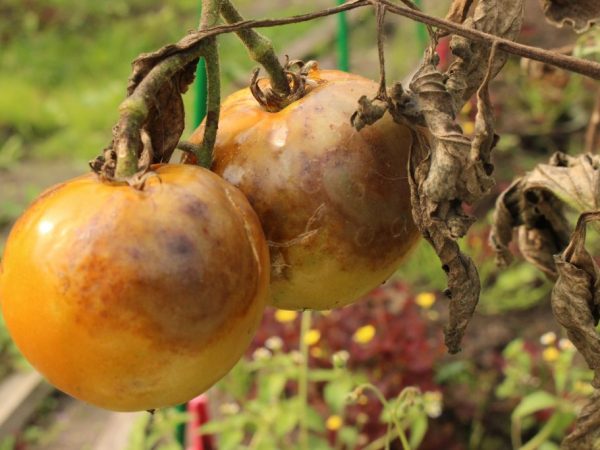
Common tomato diseases
Causes of tomato diseases
Most often, diseases of varietal tomatoes occur due to improper care. In a shaded area, during overflow, conditions are created for the growth of fungi and bacteria. The lack of minerals reduces the resistance of plants, makes it difficult to grow them.
The main causes of tomato diseases are:
- fungal infection of leaves and fruits;
- damage to plants by bacteria;
- lack or excess of minerals;
- violation of watering rules.
Often, pathogens are transmitted along with the seeds, therefore it is always recommended to disinfect the seed. The source of infection can be the soil on which the seedlings are grown, as well as the land in the garden or in the greenhouse. Consider the most common tomato diseases and their treatment.
Tatiana Orlova (Candidate of Agricultural Sciences):
All plant diseases, including tomato, are divided into infectious, caused by various pathogens and non-infectious - the result of violations of agricultural technology or the lack of suitable conditions.
Late blight
Late blight disease affects all nightshade plants, including tomatoes. Most often, the culture becomes infected from potatoes, therefore it is not recommended to plant them next to or after each other. The causative agent is Phytophthora infestans, a mushroom-like microorganism.
Symptoms
Plants are attacked at high levels of moisture, starting from the trunk, where white and brown spots appear. They then move to leaves, which curl up. Fruits are affected last. As a result, their growth and maturation stops. In a few days, the entire garden bed can die. Late blight is more typical for open ground.
Tatiana Orlova (Candidate of Agricultural Sciences):
Abundant dew and fog contribute to the onset of the disease. Such weather conditions usually develop in August, when there are sharp fluctuations in day and night temperatures, which causes the appearance of condensation on the leaves in the form of dew. The disease begins with the lower leaves, gradually affecting the entire plant.
Prophylaxis
For the prevention of late blight, you need to adhere to the rules of agricultural technology.You can not leave last year's tops in the beds, plant tomatoes 2 times in one place or next to potatoes. For prevention and treatment, the following drugs are used:
- Alerin B;
- Gamair;
- Oxyhom;
- Ridomil Gold;
- Fitosporin.
The bushes are processed 20 days after planting the seedlings, the second time after 3 weeks. If spots appear on the trunk or leaves, it is too late to take any measures. It will not be possible to save the crop, since obvious signs are the last stage of the disease.
Brown spot
Brown spot, or cladosporium, is caused by the fungus Cladosporium fulvum Cooke. It mainly affects greenhouse tomatoes, develops at high humidity (about 80%) and a temperature of 22-25 ° C. Microorganisms tolerate drying and freezing well; they can live in the ground for about 10 months.
Symptoms
With this disease of varietal tomatoes, the tomato leaf on the underside is covered with light green or gray spots. After a while, they turn brown, the leaves curl and dry out. The plant does not die, but the yield drops by half. Fruits are covered with brown spots, shrivel and fall off. The spores of the fungus spread quickly, in a short period of time they can infect all the bushes in the greenhouse.
Prophylaxis
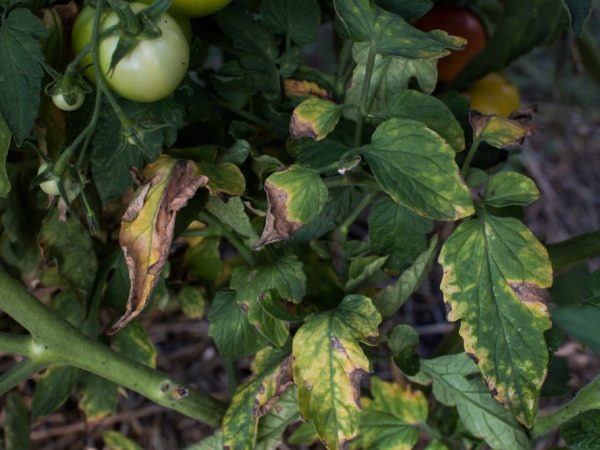
The spread of the fungus can be stopped
To prevent this tomato disease, it is recommended to maintain optimal humidity and temperature, plant tomatoes at a sufficient distance from each other. For prevention, biological products are often used:
- Pseudobacterin-2;
- Fitosporin-M;
- Integral.
If the first spots are found on the leaves, the plant must be treated with fungicides:
- Abiga Peak;
- Barrier;
- HOM;
- Poliram;
- Barrier.
In greenhouses, the humidity level is reduced to 65-70%. In such conditions, the growing season of the fungus stops. After harvesting, the tops are burned, the soil is disinfected. Tomatoes must not be planted in the same place for at least 3 years.
Brown rot
Brown rot of tomatoes, or phomosis, affects all organs of the plant. The causative agent is a fungus called Phoma destructiva. It enters the plant through minor damage, is carried by insects, through precipitation or water droplets that fall on the bushes during watering. It multiplies well at high humidity and temperatures around 20 ° C. It persists for a long time in soil, tomatoes, peppers and weeds from the genus Solanaceae.
Symptoms
When damaged, small dots of dark brown or black color appear on the leaves. The spots merge over time, concentric circles form on the stem. The voluminous fruiting bodies of the fungus are visible on the surface. Ripe and green fruits develop brown, depressed spots.
Prophylaxis
To prevent fungal infection, the bushes are treated with the "Zaslon" agent, an infusion of garlic. Do not feed tomatoes with fresh manure. It is imperative to control watering and humidity, especially in the greenhouse. What if the tomatoes are already sick? In this case, the affected stems and fruits are collected and burned, the soil is disinfected.
Top rot
Top rot is another disease of tomatoes that is caused by fungi. The most common pathogens are microorganisms of the genus Alternaria. Pathology occurs due to a lack of moisture and high temperatures. In such conditions, many saprophytic fungi are activated. The provoking factors also include the lack of nitrogen and calcium in the soil.
Tatiana Orlova (Candidate of Agricultural Sciences):
Vertex rot is a non-infectious disease. This disease is a consequence of a calcium deficiency in a tomato (or pepper) plant due to a high soil temperature (+30 degrees and above) and excessive nitrogen fertilization. Nitrogen displaces calcium from the soil complex. On dry spots of apical rot, when in contact with moist soil, saprophytic fungi settle, which cause rotting of the affected fruit.
Symptoms
Impressed spots appear on the tops of green fruits. They come in different types.In some cases, the tomatoes turn black and dry, in others the spots are brown, wet and with a rotten smell. Bushes are affected both in the open area and in the greenhouse. Crop loss is 20-30%
Prophylaxis
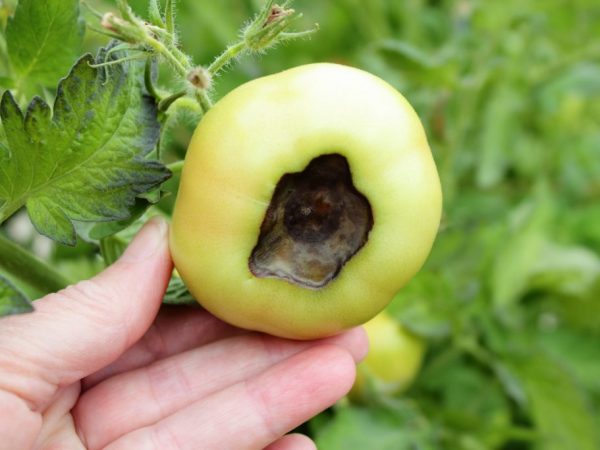
For prevention, it is important not to allow the soil to dry out
To combat the disease, you need to establish watering so that the soil does not dry out. Also, plants should be treated with preparations containing trace elements. For this purpose, apply:
- Calcium chelate;
- Brexil;
- Megafol;
- SWEET.
You can use folk methods. It is recommended to take a tablespoon of calcium nitrate, dilute it in 10 liters of water and process the bushes. Combinations of calcium and boron are very effective. For example, Brexil contains 15% calcium and 0.5% boron. Tomato bushes need to be regularly fed with nitrogenous and phosphate fertilizers.
Tatiana Orlova (Candidate of Agricultural Sciences):
Foliar dressing with calcium nitrate is carried out twice a season. The first time during the flowering of tomatoes. The second time - when the tomatoes reach the size of a walnut.
Gray rot
Gray rot is a pathology caused by the fungus Botrytis cinerea Pers. It begins to develop during the fruiting period. This disease is characterized by the defeat of tomatoes in a greenhouse. Although outdoors, the bushes can also hurt. Favorable conditions for the development of fungi are high humidity, low temperature and soil overflow.
Symptoms
First, small gray spots appear on the leaves, then the stem is affected. The gray spot grows up to 4-5 cm in diameter, covering the stem with a ring, acquires a light brown color. Above the affected area, the plant dries up, as necrosis prevents the supply of nutrients. Sometimes you can see thin air roots above the spot. Many small brown dots appear on the fruits. They resemble spots with late blight.
Prophylaxis
To combat the fungus, it is recommended to plant resistant varieties (Pilgrim, Vasilievna). It is also necessary to adhere to agricultural techniques, to prevent overflow, to plant bushes on the southern side of the site. A good result is obtained by processing with sodium humate during the growing season, it reduces the risk of gray rot by half.
If the signs of tomato disease are obvious, it is recommended to treat them with such biological and chemical agents:
- Trichodermin;
- Glyocladin;
- Euparen;
- Bayleton.
These drugs can be used for prophylaxis. Processing begins in May and is repeated every 15-20 days, until approximately the end of August.
Stem rot
This tomato disease is caused by the fungus Didymella lycopersici. The pathogen is stored in the affected parts of tomatoes and weeds, so it can survive the winter. The optimum temperature for spore germination is 20 ° C, they also like high humidity. The fungus is carried by insects, raindrops.
Symptoms
Most often, it affects the lower stems of plants. First, depressed dark brown spots form on the stem from the very base. They gradually increase, encircle the stem, move to the leaves. Fruits are affected from the side of the stalk. Ultimately, the entire bush dies.
Prophylaxis
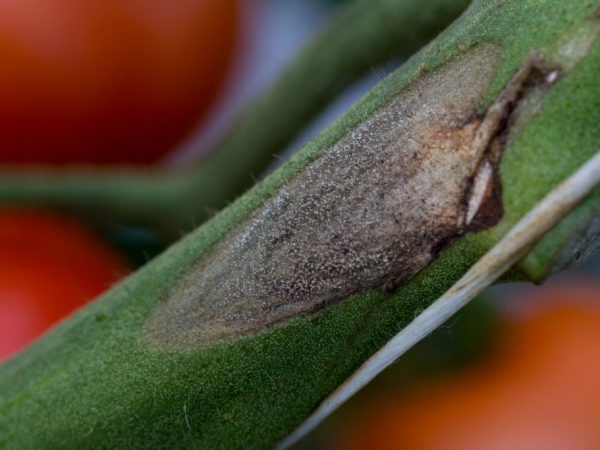
Copper sulfate will help cope with the disease
Biological preparations are used to prevent and combat stem rot. They contain certain strains of bacteria that infect and neutralize fungi. Recommend to use:
- Alirin-B;
- Glyocladin;
- Sternifag;
- Fitolavin.
A good result is obtained by treating bushes with preparations containing copper, for example, copper sulfate. It is necessary to adhere to the rules of watering and destroy all diseased plants and weeds in the garden.
Root rot
Root rot is caused by the fungi Didymella lycopersici or Pythium debaryanum. Its second name is rhizoctoniasis. Most often, pathogens infect a tomato in a greenhouse. Bushes are susceptible to fungi at any stage of development, starting with seedlings.Spores are carried by insects, wind, and can get into the soil with organic fertilizers, water for irrigation.
Symptoms
At first, the signs of the disease are invisible on the plant. When the fungus damages most of the roots, the leaves begin to wilt. They recover again at night. The lower part of the stem becomes thin and pale. In the final stage, brown or black rings are visible on the underside of the stem. If you take the tomato out of the ground, you can see that the root is completely rotten.
Prophylaxis
If a disease is detected, the affected tomatoes are removed from the garden and burned. For prevention, plants are treated with fungicides, this should be done every 15-20 days. Sprinkle the ground near the roots with wood ash or sand. To strengthen, the roots are watered with Epin or Kornevin. It is important that the temperature in the greenhouse and outside does not fall below 20 ° C, the optimum humidity regime is maintained.
Anthracosis
Tomato anthracosis is another fungal disease that is caused by the fungus Colletotrichum phomoides. It affects ripe fruits and plants in the final phase of the growing season. It spreads quickly in high humidity, lingering rains. The optimum temperature for spore germination is 20-24 ° C.
Symptoms
On ripe or green fruits of tomatoes, spots appear up to 1.5 cm in diameter. They can be depressed or flat. At first, their surface is glossy, watery, then darkening appears in the center. If the humidity level is very high, pink spores are visible on the stain. The fruits gradually rot and decay. Leaves and stems are not affected by anthracosis.
Prophylaxis
Diseased fruits should be removed. Effective protection is ensured by the following measures:
- plant varieties resistant to anthracosis (Daniela, Gabriela, NA-177);
- process seeds before sowing for seedlings;
- do not plant tomatoes and other nightshades in the garden every year;
- weeds are removed in a timely manner;
- observe the optimal watering rules (so that the soil is only slightly moist, and not wet).
Anthracosis does not cause major damage, the harvested fruits suffer the most during transportation, therefore, they should not be allowed to overripe.
Phytoplasmosis
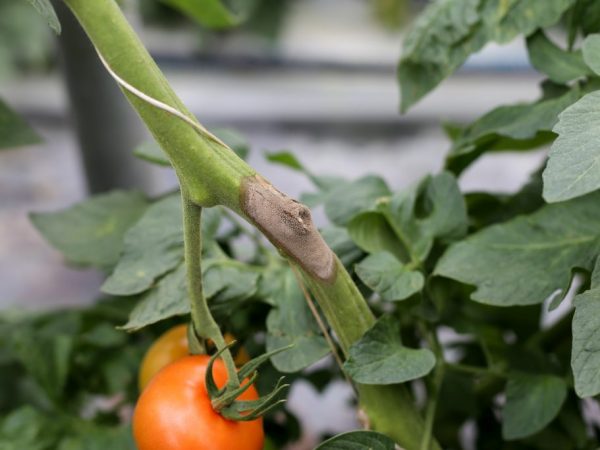
Disease caused by insects
Phytoplasmosis, or stolbur, is a disease characterized by the formation of pathological stiffness of tomatoes. Caused by the microorganism Tomato stolbur phytoplasma. Plants in the open field are most often sick. In case of a massive defeat, the entire crop can be lost over a large area. The disease is carried by leafhoppers and bedbugs. The prevalence of stolbur in certain regions depends on the number of these types of insects.
Tatiana Orlova (Candidate of Agricultural Sciences):
This disease can be transmitted from a diseased plant to a healthy plant through tools or hands that have gotten the hairs or juice of a diseased tomato. It is imperative to disinfect tools and hands after work (pinching, debris, garters) with diseased plants.
Symptoms
Symptoms of pathology largely depend on the moment of infection. If it happened in the early stages of the growing season, the stem and roots begin to grow stiff. They become hard, take on a brown tint. The leaves are small, with a pink or purple tint. The flowers are large, but empty inside, with reduced fruit rudiments. With late infestation, you may notice that the tomatoes lose color, white and yellow stripes become visible on the surface. The fruit is hard, tasteless, with areas of tissue compaction.
Prophylaxis
To prevent disease, the area must be treated with insecticides that kill the vectors. Insect larvae live in the ground and feed on plant sap through the roots, therefore, the soil should be properly prepared before planting. 25-30 days after planting tomato seedlings, the bushes should be sprayed with the following preparations:
- Confidon;
- Aktara;
- Mospilan;
- Fufanon;
- Actellik;
- Phytoplasmin.
Phytoplasmosis is one of the most dangerous diseases, but it is easy to control it if you fight insect vectors in time. Pest control is the best prevention method.
Powdery mildew
The causative agent of this tomato disease is several marsupial fungi at once. In the open field, plants are rarely affected. Pathology is typical for crops that grow in a greenhouse or greenhouse. The speed and intensity of the development of fungi depend on the temperature and humidity in the greenhouse.
Symptoms
Colonies of the fungus are formed on the leaves, which resemble a white powdery bloom. Sometimes yellow spots are visible on the upper part, and white ones below. The foliage turns pale, the spots merge with each other. Over time, the affected areas die off. Fruit petioles and stems are affected only in severe pathology.
Prophylaxis
For the treatment and prevention of powdery mildew, growth stimulants, biological and chemical preparations are used. For processing plants, the following means are recommended:
- Epin;
- Humate;
- Baktofit;
- Quadris;
- Strobe;
- Topaz;
- Tiovit Jet;
- Cumulus;
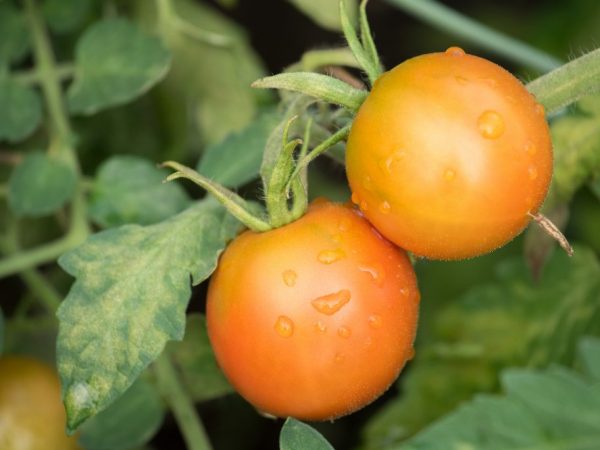
Powdery mildew can be fought
It is imperative to maintain normal temperature and humidity in the greenhouse, to regulate irrigation. After harvesting, the premises and the soil are disinfected so that the next planting does not get infected with mold.
Mosaic
This tomato disease has a viral etiology. Its causative agent contains RNA, belongs to the genus Nicotiana. Tomatoes suffer both outdoors and in greenhouses. The virus is stable in the external environment. It lives in dry tissues of tomatoes and weeds for months.
If the greenhouse is infected, it is very difficult to disinfect it. The source of pathology can be seeds, soil. It is carried by insects, wind.
Symptoms
When infected, yellow and green spots appear on the leaves. The drawing resembles a mosaic (hence the name). After a while, the leaves are deformed, twisted, growths of various shapes appear on them. The fruits are small, ripen unevenly, green spots or stripes are visible on the red skin.
Prophylaxis
To prevent the mosaic from appearing, the following measures should be taken:
- disinfect the seeds before sowing with 2% hydrochloric acid or potassium permanganate;
- steam the soil at 100 ° C for 2 hours;
- destroy weeds in the garden in time;
- fight insects that inhabit the garden.
A vaccine has recently been developed that effectively helps fight the virus. It is recommended to treat seedlings and tomatoes with the preparation during the intensive growing season. You can engage in prevention and folk methods. For this, tomatoes are treated with a solution of skim milk (1:10 with water).
Tatiana Orlova (Candidate of Agricultural Sciences):
Tomato viral diseases are known today about 16 species. There are practically no remedies against them. All control measures are only preventive in nature. Sometimes tomato bushes infected with viruses self-heal with prolonged exposure to temperatures of +35 degrees and above.
Tomato streak
Streak is a viral disease of tomatoes that is caused by a number of pathogens. Most often these are mosaic viruses of different plants. They are transferred along with old plants that remain in the ground. Sometimes insect pests (thrips, aphids, spider mites) spread the infection. The pathogen can live in seeds for a long time.
Symptoms
Describing the symptoms of a streak is difficult to deal with, as they are so varied. Dark brown streaks and stripes appear on the trunk, petioles of flowers and fruits. The leaves are covered with brown spots of irregular shape, curliness appears. The plant becomes fragile and breaks easily. Growth is inhibited, fruiting is poor, tomatoes are small, covered with dark spots. The fruits can easily crack, areas of hardening are revealed inside, the taste is reduced.
Prophylaxis
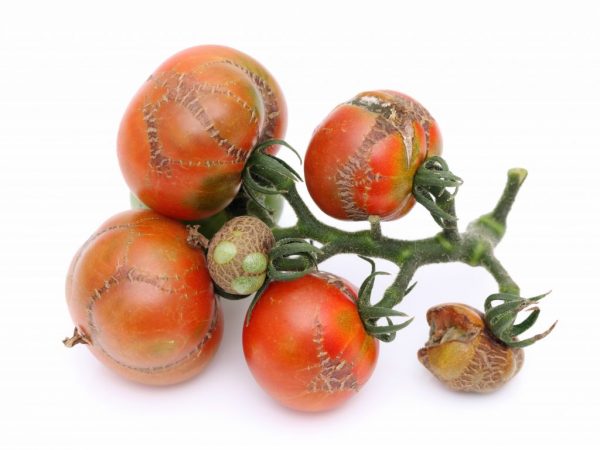
Get rid of infected plants
To prevent the disease, you should take the following measures:
- soak the seeds before planting for half an hour in a 1% solution of potassium permanganate;
- water the seedlings with a solution of potassium permanganate (0.5 g per 1 liter of water);
- water the plants in the garden with fertilizers containing zinc, sulfur, boron, manganese, copper;
- treat the bushes with succinic acid immediately after planting, then 2 more times with a break of 10 days;
- disinfect the soil with potassium permanganate solution before planting;
- make sure that the temperature is not lower than 20 ° С, and the humidity is not more than 70%;
- carefully remove the remains of plants from the garden in the fall.
If there are already symptoms, there is no way to deal with them. It is best to remove and burn all infested bushes. Do not plant new ones in this place for 3-4 years.
Yellow spot
Tomato yellow spot is another viral disease. It is caused by Tomato yellow leaf curl virus. The whitefly pathogen is transferred. It is not preserved in seeds and particles of mature plants. The first symptoms of the disease on tomatoes can be seen 20 days after infection.
Symptoms
The main sign of yellow spot is the curliness of the leaves, sometimes with the formation of pathological outgrowths. Flowers may fall off, although this is optional. Fruits become smaller and ripen poorly.
The disease is not very dangerous. The main trouble it causes is a decrease in the yield and presentation of tomatoes.
Prophylaxis
To date, one variety resistant to this disease has been bred - Senzafin. For prevention, it is recommended to treat the bushes with mineral oils. It is advisable to deal with whiteflies, which like to settle in plots and in greenhouses. There is no effective drug for treating the infection yet. If the tomatoes are sick, it is better to collect them from the garden and burn them.
Black bacterial spot
Tomato disease is caused by the gram-negative bacillus Xanthomonas vesicatoria. The bacteria can infect the stems and leaves of mature plants. The pathogen penetrates the stomata, cracks and lesions. Most often, the disease is transmitted along with the seeds. It parasitizes inside, therefore, the seed can only be disinfected by etching. It develops best at a humidity of 70-75% and a temperature of 25-30 ° C.
Symptoms
Olive dots appear on the affected leaves, 1-2 mm in diameter. Then they become larger, darken, spread to all parts of the plant. The spots do not merge, their maximum diameter is 5-6 mm. The tomato appears to be covered with a black rash. The leaves begin to dry out and fall off, the bush becomes almost naked. Tomato fruits stop growing and do not ripen. Crop losses can reach 90-100%.
Prophylaxis
To prevent infection, the seeds are treated with sodium or calcium hypochlorite, trisodium phosphate. The seed dressing is carried out with the biological product Planriz. For processing seedlings, the following means are used:
- Planriz;
- Fitosporin-M;
- Baktofit;
- Gamair;
- Phytoflavin.
In order to prevent bacterial disease of tomatoes, the seedlings are treated for the first time when 2-3 true leaves appear. The second time - before disembarking in open ground. Garden tomatoes can be sprayed every 20-25 days. If the first signs of the disease are detected, the affected leaves should be torn off and the plants should be treated with the means listed above.
Tomato bacterial cancer
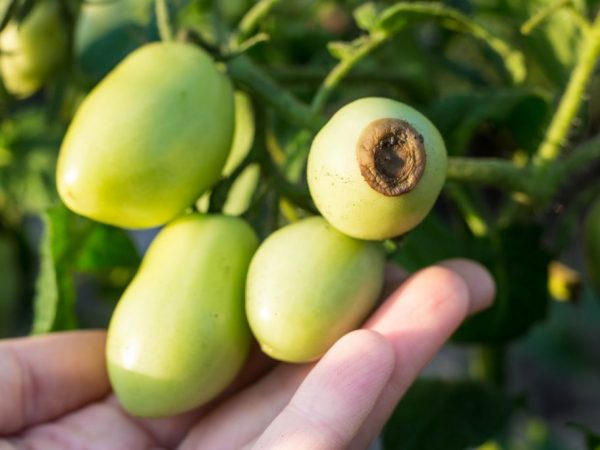
Disease can kill an entire crop
The disease is caused by different bacteria or a combination of them. The most common pathogens are Clavibacter michiganensis, Corynebacterium michiganensis. The incubation period lasts more than 2 months, because the first signs of pathology are noticeable on the bushes before fruiting itself. It is transmitted together with seeds, less often - through the soil. The optimum temperature for the development of bacteria is 25 ° C.
Symptoms
Tomato disease can take two forms. At the first, the vascular system is affected. The stem begins to rot from the inside, the whole plant dies. In the second form, leaves and fruits are affected, it is not so malignant.The main symptoms of bacterial cancer are wilting of the bush, the appearance of dark spots on the leaves and fruits. The loss of yield in this disease is about 30%.
Prophylaxis
To prevent the disease, you need to properly process the seeds before planting. To do this, use:
- Phytoflavin;
- Formalin (diluted with water 1: 100);
- Hydrochloric acid 2% concentration.
Seedlings after the appearance of two true leaves are also treated with 0.2% phytoflavin. It is also recommended to process the soil. Before planting seedlings, you can fry it in the oven, pour it with a strong solution of potassium permanganate. In the greenhouse, the ground is watered with carbation or formalin.
There is no cure for bacterial cancer. If the plants get sick, they are destroyed, because so much attention is paid to prevention.
Lack of minerals
There are tomato diseases associated with a lack or excess of minerals in the soil. It is important to know their symptoms in order to properly fertilize under the bushes. The main minerals are responsible for these processes:
- Phosphorus. Influences the development of roots, the resistance of plants to cold.
- Calcium. Responsible for the growth and assimilation of water, resistance to infections and adverse environmental factors.
- Zinc. Affects growth.
- Magnesium. Responsible for the yield of the crop.
- Molybdenum. It is a nitrate antagonist.
- Nitrogen. Responsible for the growth of the green mass of the plant.
- Sulfur. An element responsible for photosynthesis.
- Chlorine. Regulates the absorption of nitrates.
Symptoms
With a lack of phosphorus, nitrogen, potassium, magnesium and zinc, the leaves are deformed, the lower ones fall off. With a nitrogen deficiency, the leaves become small, pale, and may fall off. If the green mass of the plant is very lush, the leaves are large, then there is too much nitrogen. This can affect the yield, all the energy of the bush will go to the formation of the crown, the fruits will be small, few in number.
If there is little calcium in the soil, the leaves turn pale, the flowers fall off, and the fruits darken from above. With a lack of sulfur, the foliage is small, weak, thinned. If the tomatoes are low in iron, the leaves begin to turn yellow, the flowers become small, and develop poorly. The lack of chlorine leads to a decrease in plant resistance, an increase in the risk of infectious diseases.
Prophylaxis
It is necessary to establish watering, fertilize. It is recommended to feed tomato bushes 2-3 times per season. At the beginning of the growing season, nitrogenous mixtures are used, during the fruiting period - fertilizing with calcium and magnesium. Some farmers practice cultivation without additional feeding, but such methods do not justify themselves.
General rules for the prevention of diseases
There are different ways to prevent tomato diseases. It is very important to adhere to all the rules of agricultural technology, then the tomatoes will grow without problems and bring a good harvest. Here are some basic rules:
- Fertilizers must be balanced and applied on time.
- Care should be taken very carefully so as not to damage the bushes. Cracks, scratches, and fractures can be gateways for infection.
- To protect the soil from drying out, to prevent moisture from entering the stems, mulch should be used.
- It is important to observe the timing and methods of planting.
- It is best to choose disease-resistant varieties and hybrids for cultivation.
- You need to plant bushes at an optimal distance.
It is believed that growing tomatoes in a greenhouse is more profitable, but in this case, you should adhere to all the rules, disinfect greenhouses in time. Only proper care can ensure a stable crop yield and prevent any tomato diseases.



